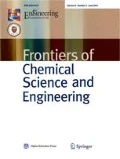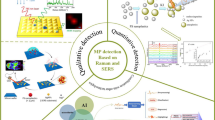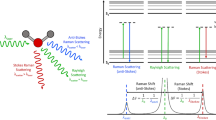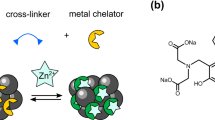Abstract
Perchlorate has recently emerged as a widespread environmental contaminant of healthy concern. Development of novel detection methods for perchlorate with the potential for field use has been an urgent need. The investigation has shown that surface-enhanced Raman scattering (SERS) technique has great potential to become a practical analysis tool for the rapid screening and routine monitoring of perchlorate in the field, particularly when coupled with portable/handheld Raman spectrometers. In this review article, we summarize progress made in SERS analysis of perchlorate in water and other media with an emphasis on the development of SERS substrates for perchlorate detection. The potential of this technique for fast screening and field testing of perchlorate-contaminated environmental samples is discussed. The challenges and possible solutions are also addressed, aiming to provide a better understanding on the development directions in the research field.

Similar content being viewed by others
References
Wang C, Lippincott L, Yoon I H, Meng X. Modeling, rate-limiting step investigation, and enhancement of the direct bio-regeneration of perchlorate laden anion-exchange resin. Water Research, 2009, 43(1): 127–136
Renner R. U.S.Focus.Perchlorate rockets to US national attention. Journal of Environmental Monitoring, 1999, 1(3): 37N–38N
Yoon I H, Meng X, Wang C, Kim K W, Bang S, Choe E, Lippincott L. Perchlorate adsorption and desorption on activated carbon and anion exchange resin. Journal of Hazardous Materials, 2009, 164(1): 87–94
Perchlorate: occurrence is widespread but at varying levels; Federal agencies have taken some actions to respond to and lessen releases. Washington: United States Government Accountability Office, 2010
Dasgupta P K. Perchlorate: An enigma for the new millennium. Analytica Chimica Acta, 2006, 567(1): 1–3
Wang C, Lippincott L, Meng X. Feasibility and kinetics study on the direct bio-regeneration of perchlorate laden anion-exchange resin. Water Research, 2008, 42(18): 4619–4628
Kirk A B. Environmental perchlorate: Why it matters. Analytica Chimica Acta, 2006, 567(1): 4–12
Baier-Anderson C. Risk assessment, remedial decisions and the challenge to protect public health: The perchlorate case study. Analytica Chimica Acta, 2006, 567(1): 13–19
Wang W, Gu B. New surface-enhanced Raman spectroscopy substrates via self-Assembly of silver nanoparticles for perchlorate detection in water. Applied Spectroscopy, 2005, 59(12): 1509–1515
Mosier-Boss P A. Use of Raman spectroscopy to evaluate the selectivity of bifunctional anion exchange resins for perchlorate. Applied Spectroscopy, 2008, 62(2): 157–165
Kumarathilaka P, Oze C, Indraratne S P, Vithanage M. Perchlorate as an emerging contaminant in soil, water and food. Chemosphere, 2016, 150: 667–677
Public health goal for perchlorate in drinking water. Pesticide and environmental toxicology branch. California: Office of Environmental Health Hazard Assessment, California Environmental Protection Agency, 2015
Wang W, Ruan C, Gu B. Development of gold–silica composite nanoparticle substrates for perchlorate detection by surfaceenhanced Raman spectroscopy. Analytica Chimica Acta, 2006, 567(1): 121–126
Gu B, Ruan C, Wang W. Perchlorate detection at nanomolar concentrations by surface-enhanced Raman scattering. Applied Spectroscopy, 2009, 63(1): 98–102
Mosier-Boss P A, Putnam M D. Detection of perchlorate using Ag/DMAH + SERS-active capture matrices. Spectrochimica Acta. Part A: Molecular and Biomolecular Spectroscopy, 2014, 133: 156–164
Sharma B, Frontiera R R, Henry A I, Ringe E, van Duyne R P. SERS: Materials, applications, and the future. Materials Today, 2012, 15(1–2): 16–25
Cheng H W, Luo J, Zhong C J. SERS nanoprobes for bioapplication. Frontiers of Chemical Science and Engineering, 2015, 9(4): 428–441
Mosier-Boss P A, Lieberman S H. Detection of anions by normal Raman spectroscopy and surface-enhanced Raman spectroscopy of cationic-coated substrates. Applied Spectroscopy, 2003, 57(9): 1129–1137
Gu B, Tio J, Wang W, Ku Y K, Dai S. Raman spectroscopic detection for perchlorate at low concentrations. Applied Spectroscopy, 2004, 58(6): 741–744
Ruan C, Wang W, Gu B. Surface-enhanced Raman scattering for perchlorate detection using cystamine-modified gold nanoparticles. Analytica Chimica Acta, 2006, 567(1): 114–120
Tan S, Erol M, Sukhishvili S, Du H. Substrates with discretely immobilized silver nanoparticles for ultrasensitive detection of anions in water using surface-enhanced Raman scattering. Langmuir, 2008, 24(9): 4765–4771
Hao J, Xu Z, Han M J, Xu S, Meng X. Surface-enhanced Raman scattering analysis of perchlorate using silver nanofilms deposited on copper foils. Colloids and Surfaces. A, Physicochemical and Engineering Aspects, 2010, 366(1–3): 163–169
Hao J, Han M J, Li J, Meng X. Surface modification of silver nanofilms for improved perchlorate detection by surface-enhanced Raman scattering. Journal of Colloid and Interface Science, 2012, 377(1): 51–57
Hao J, Han M J, Meng X, Weimer W, Wang Q K. Surface-enhanced Raman scattering of perchlorate on cationic-modified silver nanofilms—effect of inorganic anions. Spectrochimica Acta. Part A: Molecular and Biomolecular Spectroscopy, 2015, 136(Part C): 1593–1599
Xiao J, Zhang T, Li R, Meng Y, Wen W. Surface-enhanced Raman scattering for quantitative analysis of perchlorate using poly (diallyldimethylammonium chloride) capped gold nanoparticles. Applied Spectroscopy, 2012, 66(9): 1027–1033
Stewart A, Murray S, Bell S E J. Simple preparation of positively charged silver nanoparticles for detection of anions by surfaceenhanced Raman spectroscopy. Analyst (London), 2015, 140(9): 2988–2994
Zhu S, Zhang X, Cui J, Shi Y, Jiang X, Liu Z, Zhan J. Silver nanoplate-decorated copper wire for the on-site microextraction and detection of perchlorate using a portable Raman spectrometer. Analyst (London), 2015, 140(8): 2815–2822
Nuntawong N, Eiamchai P, Limwichean S, Wong-ek B, Horprathum M, Patthanasettakul V, Leelapojanaporn A, Nakngoenthong S, Chindaudom P. Trace detection of perchlorate in industrial-grade emulsion explosive with portable surface-enhanced Raman spectroscopy. Forensic Science International, 2013, 233(1-3): 174–178
Kneipp K, Kneipp H, Itzkan I, Dasari R R, Feld M S. Ultrasensitive chemical analysis by Raman spectroscopy. Chemical Reviews, 1999, 99(10): 2957–2976
Halvorson R A, Vikesland P J. Surface-enhanced Raman spectroscopy (SERS) for environmental analyses. Environmental Science & Technology, 2010, 44(20): 7749–7755
Baker G A, Moore D S. Progress in plasmonic engineering of surface-enhanced Raman-scattering substrates toward ultra-trace analysis. Analytical and Bioanalytical Chemistry, 2005, 382(8): 1751–1770
Kneipp K, Kneipp H, Itzkan I, Dasari R R, Feld M S. Surfaceenhanced Raman scattering and biophysics. Journal of Physics Condensed Matter, 2002, 14(18): R597
Wei H, Hossein Abtahi S M, Vikesland P J. Plasmonic colorimetric and SERS sensors for environmental analysis. Environmental Science. Nano, 2015, 2(2): 120–135
Alvarez-Puebla R A, Liz-Marzán L M. SERS detection of small inorganic molecules and ions. Angewandte Chemie International Edition, 2012, 51(45): 11214–11223
Kneipp K, Wang Y, Kneipp H, Perelman L T, Itzkan I, Dasari R R, Feld MS. Single molecule detection using surface-enhanced Raman scattering (SERS). Physical Review Letters, 1997, 78(9): 1667–1670
Nie S, Emory S R. Probing single molecules and single nanoparticles by surface-enhanced Raman scattering. Science, 1997, 275(5303): 1102–1106
Mulvihill M, Tao A, Benjauthrit K, Arnold J, Yang P. Surfaceenhanced Raman spectroscopy for trace arsenic detection in contaminated water. Angewandte Chemie International Edition, 2008, 47(34): 6456–6460
Han MJ, Hao J, Xu Z, Meng X. Surface-enhanced Raman scattering for arsenate detection on multilayer silver nanofilms. Analytica Chimica Acta, 2011, 692(1–2): 96–102
Xu Z, Hao J, Li F, Meng X. Surface-enhanced Raman spectroscopy of arsenate and arsenite using Ag nanofilm prepared by modified mirror reaction. Journal of Colloid and Interface Science, 2010, 347(1): 90–95
Jia S, Li D, Fodjo E K, Xu H, Deng W, Wu Y, Wang Y. Simultaneous preconcentration and ultrasensitive on-site SERS detection of polycyclic aromatic hydrocarbons in seawater using hexanethiol-modified silver decorated graphene nanomaterials. Analytical Methods, 2016, 8(42): 7587–7596
Zhang Y, Wang Z, Wu L, Pei Y, Chen P, Cui Y. Rapid simultaneous detection of multi-pesticide residues on apple using SERS technique. Analyst (London), 2014, 139(20): 5148–5154
Alvarez-Puebla R A, Liz-Marzan L M. Environmental applications of plasmon assisted Raman scattering. Energy & Environmental Science, 2010, 3(8): 1011–1017
Fan M, Andrade G F S, Brolo A G. A review on the fabrication of substrates for surface enhanced Raman spectroscopy and their applications in analytical chemistry. Analytica Chimica Acta, 2011, 693(1–2): 7–25
Sharma B, Fernanda Cardinal M, Kleinman S L, Greeneltch N G, Frontiera R R, Blaber M G, Schatz G C, van Duyne R P. Highperformance SERS substrates: Advances and challenges. MRS Bulletin, 2013, 38(8): 615–624
Li D W, Zhai W L, Li Y T, Long Y T. Recent progress in surface enhanced Raman spectroscopy for the detection of environmental pollutants. Mikrochimica Acta, 2014, 181(1–2): 23–43
Hao J, Han M J, Xu Z, Li J, Meng X. Fabrication and evolution of multilayer silver nanofilms for surface-enhanced Raman scattering sensing of arsenate. Nanoscale Research Letters, 2011, 6(1): 263
Chen C, Hao J, Zhu L, Yao Y, Meng X, Weimer W, Wang Q K. Direct two-phase interfacial self-assembly of aligned silver nanowire films for surface enhanced Raman scattering applications. Journal of Materials Chemistry. A, Materials for Energy and Sustainability, 2013, 1(43): 13496–13501
Du J, Cui J, Jing C. Rapid in situ identification of arsenic species using a portable Fe3O4@Ag SERS sensor. Chemical Communications, 2014, 50(3): 347–349
Fateixa S, Nogueira H I S, Trindade T. Hybrid nanostructures for SERS: Materials development and chemical detection. Physical Chemistry Chemical Physics, 2015, 17(33): 21046–21071
Chen MC, Tsai S D, Chen MR, Ou S Y, Li WH, Lee K C. Effect of silver-nanoparticle aggregation on surface-enhanced Raman scattering from benzoic acid. Physical Review B: Condensed Matter and Materials Physics, 1995, 51(7): 4507–4515
Dou X, Jung Y M, Cao Z Q, Ozaki Y. Surface-enhanced Raman scattering of biological molecules on metal colloid II: Effects of aggregation of gold colloid and comparison of effects of pH of glycine solutions between gold and silver colloids. Applied Spectroscopy, 1999, 53(11): 1440–1447
Zou X, Dong S. Surface-enhanced Raman scattering studies on aggregated silver nanoplates in aqueous solution. Journal of Physical Chemistry B, 2006, 110(43): 21545–21550
Tian Z Q, Ren B, Wu D Y. Surface-enhanced Raman scattering: âFrom noble to transition metals and from rough surfaces to ordered nanostructures. Journal of Physical Chemistry B, 2002, 106(37): 9463–9483
Hu J, Zhao B, Xu W, Fan Y, Li B, Ozaki Y. Simple method for preparing controllably aggregated silver particle films used as surface-enhanced Raman scattering active substrates. Langmuir, 2002, 18(18): 6839–6844
Sackmann M, Materny A. Surface enhanced Raman scattering (SERS)—a quantitative analytical tool? Journal of Raman Spectroscopy, 2006, 37(1–3): 305–310
Rajesh D, Mahendar M, Sunandana C S. Effect of etching on the optical, morphological properties of Ag thin films for SERS active substrates. Journal of Chemistry, 2013, 2013: 285431
Zheng J, He L. Surface-enhanced Raman spectroscopy for the chemical analysis of food. Comprehensive Reviews in Food Science and Food Safety, 2014, 13(3): 317–328
Pang S, Yang T, He L. Review of surface enhanced Raman spectroscopic (SERS) detection of synthetic chemical pesticides. TrAC Trends in Analytical Chemistry, 2016, 85: 73–82
Song C, Yang B, Yang Y, Wang L. SERS-based mercury ion detections: Principles, strategies and recent advances. Science China. Chemistry, 2016, 59(1): 16–29
Shaban M, Galaly A R. Highly sensitive and selective in-situ SERS detection of Pb2+, Hg2+, and Cd2+ using nanoporous membrane functionalized with CNTs. Scientific Reports, 2016, 6: 25307
Han D, Lim S Y, Kim B J, Piao L, Chung T D. Mercury(ii) detection by SERS based on a single gold microshell. Chemical Communications, 2010, 46(30): 5587–5589
Wang Y, Irudayaraj J. A SERS DNAzyme biosensor for lead ion detection. Chemical Communications, 2011, 47(15): 4394–4396
Ruan C, Luo W, Wang W, Gu B. Surface-enhanced Raman spectroscopy for uranium detection and analysis in environmental samples. Analytica Chimica Acta, 2007, 605(1): 80–86
Bhandari D, Wells S M, Retterer S T, Sepaniak M J. Characterization and detection of uranyl ion sorption on silver surfaces using surface enhanced Raman spectroscopy. Analytical Chemistry, 2009, 81(19): 8061–8067
Li J, Chen L, Lou T, Wang Y. Highly sensitive SERS detection of As3+ ions in aqueous media using glutathione functionalized silver nanoparticles. ACS Applied Materials & Interfaces, 2011, 3(10): 3936–3941
Xiao J, Meng Y Y, Zhang P L, Wen W, Liu Z M, Zhang T. Quantitative analysis of chromate (CrVI) by normal Raman spectroscopy and surface-enhanced Raman spectroscopy using poly(diallyldimethylammonium) chloride-capped gold nanoparticles. Laser Physics, 2012, 22(10): 1481–1488
Zhou W, Yin B C, Ye B C. Highly sensitive surface-enhanced Raman scattering detection of hexavalent chromium based on hollow sea urchin-like TiO2@Ag nanoparticle substrate. Biosensors & Bioelectronics, 2017, 87: 187–194
Mosier-Boss P A, Putnam M D. Detection of hexavalent chromium using gold/4-(2-mercaptoethyl) pyridinium surface enhanced Raman scattering-active capture matrices. Analytica Chimica Acta, 2013, 801: 70–77
Mosier-Boss P A, PutnamMD. The evaluation of two commercially available, portable Raman systems. Analytical Chemistry Insights. Analytical Chemistry Insights, 2013, 8: 83–97
Dieringer J A, McFarland A D, Shah N C, Stuart D A, Whitney A V, Yonzon C R, Young M A, Zhang X, van Duyne R P. Introductory lecture surface enhanced Raman spectroscopy: New materials, concepts, characterization tools, and applications. Faraday Discussions, 2006, 132: 9–26
Jia S, Li D, Fodjo E K, Xu H, Deng W, Wu Y, Wang Y. Simultaneous preconcentration and ultrasensitive on-site SERS detection of polycyclic aromatic hydrocarbons in seawater using hexanethiol-modified silver decorated graphene nanomaterials. Analytical Methods, 2016, 8(42): 7587–7596
Gao P, Patterson M L, Tadayyoni M A, Weaver M J. Gold as a ubiquitous substrate for intense surface-enhanced Raman scattering. Langmuir, 1985, 1(1): 173–176
Niaura G, Malinauskas A. Surface-enhanced Raman spectroscopy of ClO4–and SO4 2–anions adsorbed at a Cu electrode. Journal of the Chemical Society, Faraday Transactions, 1998, 94(15): 2205–2211
Kania S, Holze R. Surface enhanced Raman spectroscopy of anions adsorbed on foreign metal modified gold electrodes. Surface Science, 1998, 408(1–3): 252–259
Sant’Ana A C, Alves W A, Santos R H A, Ferreira A M D, Temperini M L A. The adsorption of 2,2':6',2''-terpyridine, 4'-(5-mercaptopentyl)-2,2':6',2''-terpyridinyl, and perchlorate on silver and copper surfaces monitored by SERS. Polyhedron, 2003, 22(13): 1673–1682
Holze R. Preparation of gold electrodes for surface enhanced Raman spectroscopy SERS. Surface Science, 1988, 202(3): L612–L620
Mosier-Boss P A, Lieberman S H. Detection of nitrate and sulfate anions by normal Raman spectroscopy and SERS of cationiccoated, silver substrates. Applied Spectroscopy, 2000, 54(8): 1126–1135
Zhou Q, Kim T. Review of microfluidic approaches for surfaceenhanced Raman scattering. Sensors and Actuators. B, Chemical, 2016, 227: 504–514
Yogarajah N, Tsai S S H. Detection of trace arsenic in drinking water: Challenges and opportunities for microfluidics. Environmental Science: Water Research & Technology, 2015, 1(4): 426–447
Parisi J, Dong Q, Lei Y. In situ microfluidic fabrication of SERS nanostructures for highly sensitive fingerprint microfluidic-SERS sensing. RSC Advances, 2015, 5(19): 14081–14089
Author information
Authors and Affiliations
Corresponding author
Additional information
Dr. Xiaoguang Meng is a professor at the Center for Environmental Systems in Stevens Institute of Technology, USA. He earned his PhD degree in Environmental Engineering from Syracuse University. His research is focused on environmental surface chemistry, development of chemical and physical processes for treatment of arsenic and heavy metals, removal and recovery of phosphate in wastewater, and SERS detection of environmental contaminants. He has published more than 80 papers in peer reviewed scientific journals, obtained four US patents, and edited a book. He developed an effective household filtration process and successfully demonstrated it in nearly hundreds of families in Bangladesh. He developed a nanocrystalline titanium dioxide adsorbent and the patented material has been used in filters for treatment of arsenic, lead and other heavy metals.
Rights and permissions
About this article
Cite this article
Hao, J., Meng, X. Recent advances in SERS detection of perchlorate. Front. Chem. Sci. Eng. 11, 448–464 (2017). https://doi.org/10.1007/s11705-017-1611-9
Received:
Accepted:
Published:
Issue Date:
DOI: https://doi.org/10.1007/s11705-017-1611-9




